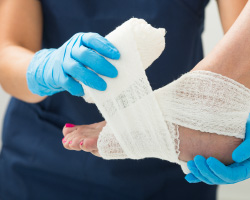
When it comes to sports injuries, prevention is definitely the best medicine.
Wearing the proper equipment, staying in shape and not pushing yourself too far too fast are all steps that may help keep you safe.
But even when you take every possible precaution, injuries can still happen. Fortunately, many of these injuries can be treated at home.
When to seek help
The first thing to remember about dealing with sports injuries is to stop as soon as you feel pain. Continuing will only cause further harm, according to the National Institute of Arthritis and Musculoskeletal and Skin Diseases (NIAMS).
With an injury such as a visible dislocation or a broken bone, it's likely to be obvious that you need medical attention. But with other injuries it may be less clear.
The NIAMS says you should call a healthcare professional if:
- The injury causes severe pain, swelling or numbness.
- You can't tolerate any weight on the affected area.
- You have increased swelling or joint instability along with the pain or dull ache of an old injury.
If you don't have any of the above symptoms, it's probably safe to begin treating your injury at home, the NIAMS says. But if discomfort or other symptoms, such as mild swelling, persist for more than a couple of days or get worse, contact your doctor.
RICE for what ails you
The first line of self-treatment for many sports injuries is RICE—Rest, Ice, Compression and Elevation. Using the RICE method may help you lessen pain and inflammation and heal more quickly.
Rest. With most sports injuries, getting the affected body part moving again as soon as possible will help you heal more quickly, according to the NIAMS. But for at least 48 hours, it may be helpful to reduce your regular activities and exercise.
Ice. Apply an ice pack to the injured area for 20 minutes at a time, four to eight times a day. Use an ice bag, cold pack or plastic bag filled with crushed ice and wrapped in a towel (don't put ice directly on your skin).
Compression. Compression, or wrapping of an injured area, such as an ankle, knee or wrist, may help reduce swelling. Elastic wraps, special boots, air casts or splints may do the job. Ask your doctor which would be best for you.
Elevation. When possible, keep your injured body part resting on a pillow above the level of your heart. This may reduce swelling.
Other treatments
In addition to the RICE technique, there are other self-treatments that may be helpful as well.
Nonsteroidal anti-inflammatory drugs (NSAIDs) are medications that may reduce inflammation and pain. Many of these medicines, such as aspirin, ibuprofen, ketoprofen and naproxen sodium, are available over-the-counter. You can also get stronger versions of NSAIDs with a prescription.
NSAIDs can cause side effects. So it's wise to talk to your doctor or pharmacist about whether the drugs are right for you and how often you should take them.
Heat applied to the injured area may sometimes help relieve muscle tension and increase blood flow. Do not use heat within 48 hours of an injury, however. If applied too early, it may make internal bleeding and swelling worse.
Massage of the injured area can sometimes help soothe tense muscles and increase blood flow.
Getting back in the game
Too often people who are injured try to return to activity as soon as their swelling subsides or their limp improves. Even if you're feeling better you may not be fully recovered, warns the American Orthopaedic Society for Sports Medicine. And a return that occurs too quickly is an invitation for re-injury.
It's best to have a plan for a gradual return to action. For guidance, speak with your doctor.
Reviewed 7/2/2025